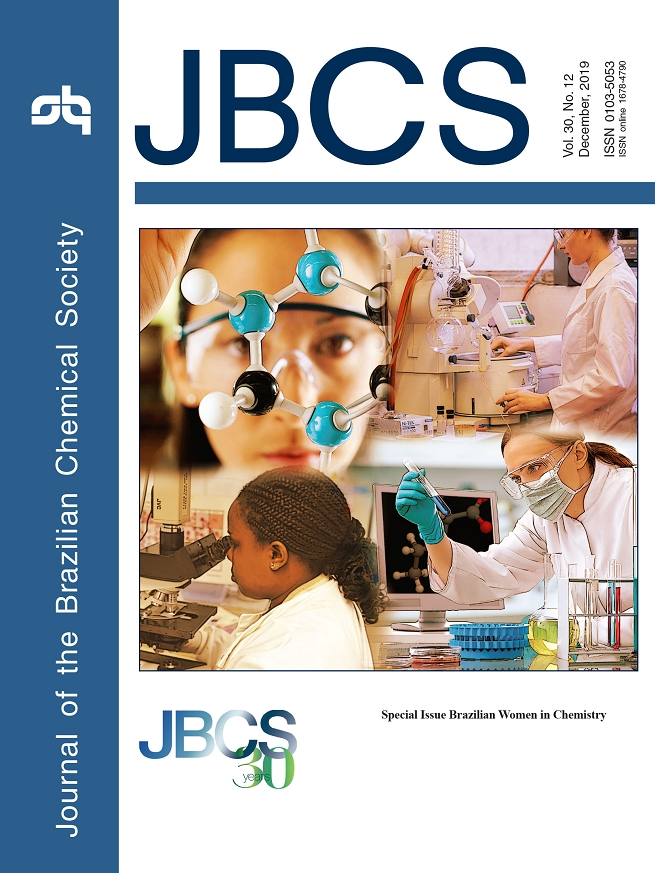vol. 30, No. 12, 2019, p. 2501-2736
For Gender Equality in Science
"All spiritual perfection is a real benefit:
Well then, science is spiritual perfection:
So science is a real benefit. '
(Princess Isabel file, Grão Pará Archive)1
Promoting the inclusion of women and girls implies to create opportunities for intellectual growth and to fight inequalities in access to skills, health, education, protection, profession, and well-being. In this context, it is stimulating to follow the promising worldwide progress towards the implementation of the 2030 United Nations' Agenda for Sustainable Development, which includes the achievement of gender equality and empowerment of all women and girls as a goal. The commitment of world leaders to this Agenda has given rise to several cheering initiatives, although there is still a long way to go before we genuinely approach sustainable development through the necessary combination of economic growth, social inclusion, and environmental protection.
To add to these efforts and mark the 30th anniversary of its first launching in 1990, the Journal of the Brazilian Chemical Society now publishes a special volume to honor the work of distinguished Brazilian Women in Chemistry. It contains original contributions in all aspects of Chemistry within the scope of the JBCS, submitted by women research leaders who illustrate and represent the quality of the current Brazilian chemical science. Given the enthusiastic welcome given by the community to this idea, reflected in the high number of submissions received for this special volume, the original proposal to release it in just one issue has been expanded to three. As part of this successful initiative of the Brazilian Chemical Society, the Editorial Board of the JBCS thanks all authors for considering our invitation and joining us on this special anniversary celebration.
1. Filgueiras, C. A. L.; Quim. Nova, 2004, 27, 349.
(Read more at Editorial)
Special Issue Brazilian Women in Chemistry
Review J. Braz. Chem. Soc. 2019, 30(12), 2501-2535
The Research on Porphyrins and Analogues in Brazil: A Small Review Covering Catalytic and other Applications since the Beginning at Universidade de Sao Paulo in Ribeirao Preto until the Joint Venture between Brazilian Researchers and Colleagues from Universidade de Aveiro, Portugal
Shirley Nakagaki  ; Kelly A. D. F. Castro; Maria da Graça P. M. S. Neves; Maria do Amparo Faustino; Yassuko Iamamoto
; Kelly A. D. F. Castro; Maria da Graça P. M. S. Neves; Maria do Amparo Faustino; Yassuko Iamamoto
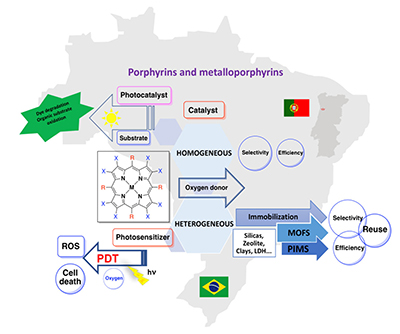
The aim of this review is to provide insight into porphyrin chemistry research in Brazilian institutions, especially that involving catalytic purposes, and discuss some advances achieved in the topic with the collaboration of researchers from the Universidade de Aveiro, Portugal.
https://dx.doi.org/10.21577/0103-5053.20190153
J. Braz. Chem. Soc. 2019, 30(12), 2536-2560
(Bio)conjugation Strategies Applied to Fluorescent Semiconductor Quantum Dots
Goreti Pereira; Camila A. P. Monteiro; Gabriela M. Albuquerque; Maria I. A. Pereira; Mariana P. Cabrera; Paulo E. Cabral Filho; Giovannia A. L. Pereira; Adriana Fontes; Beate S. Santos

In this review we present the state of the art of (bio)conjugation strategies applied to semiconductor quantum dots for biomedical / bioanalytical purposes.
https://dx.doi.org/10.21577/0103-5053.20190163
Articles J. Braz. Chem. Soc. 2019, 30(12), 2561-2566
A New Tetraglycosylated Flavonoid from Leaves of Platycyamus regnellii Benth. Isolated by High-Speed Countercurrent Chromatography
Carla M. Leal; Ricardo M. Borges; Rosineide C. Simas; Fernanda N. Costa; Gilda G. Leitao

A new tetraglycosylated flavonoid was isolated from the butanol extract of leaves of Platycyamus regnellii using high-speed countercurrent chromatography (HSCCC).
https://dx.doi.org/10.21577/0103-5053.20190143
J. Braz. Chem. Soc. 2019, 30(12), 2567-2574
Acid Hydrolysis of Regular Corn Starch under External Electric Field
Nádya P. da Silveira  ; Roberta Zucatti; Andrielle D. Vailatti; Daiani C. Leite
; Roberta Zucatti; Andrielle D. Vailatti; Daiani C. Leite
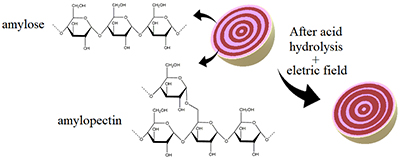
Acid hydrolysis of regular corn starch under external electric field greatly reduces the reaction time and increases starch crystallinity. Amylose and amylopectin are depicted in light and dark pink, respectively.
https://dx.doi.org/10.21577/0103-5053.20190168
J. Braz. Chem. Soc. 2019, 30(12), 2575-2581
Multi-Energy Calibration: A Practical Method for Determination of Macro and Micro Nutrients in Meat by ICP OES
Julymar M. Higuera  ; Ana Beatriz S. Silva
; Ana Beatriz S. Silva  ; Ana Rita A. Nogueira
; Ana Rita A. Nogueira

Multi-energy calibration (MEC) was successfully employed to nutrients determination in beef and meats of sheep and chicken by inductively coupled plasma optical spectrometry (ICP OES).
https://dx.doi.org/10.21577/0103-5053.20190171
J. Braz. Chem. Soc. 2019, 30(12), 2582-2589
Feasibility of a New Method for Identification and Discrimination of Gunshot Residues by Total Reflection X-Ray Fluorescence and Principal Component Analysis
Luisa P. Ferreira; Clésia C. Nascentes  ; Frederico N. Valladao; Rogério A. Lordeiro
; Frederico N. Valladao; Rogério A. Lordeiro

A simple and innovative method to identify gunshot residues and discriminate ammunition of six different calibers employing total reflection X-ray fluorescence (TXRF) and chemometric tools.
https://dx.doi.org/10.21577/0103-5053.20190173
J. Braz. Chem. Soc. 2019, 30(12), 2590-2598
Synthesis of Hybrid Monolithic Columns Using a Click Chemistry Reaction for Application in Capillary Liquid Chromatography
Marcella E. P. Schmidt; Carla B. G. Bottoli
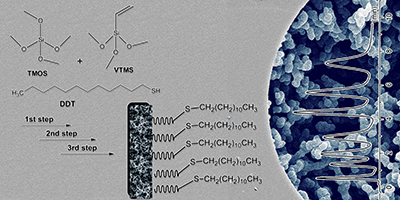
Synthesis of a hybrid monolith using a thiol-ene click chemistry reaction, for use in capillary liquid chromatography.
https://dx.doi.org/10.21577/0103-5053.20190174
J. Braz. Chem. Soc. 2019, 30(12), 2599-2609
Nanostructured Systems Obtention Using LbL Self-Assembly or the Cysteine-Assisted Adsorption Method and Their Application as a Water Splitting Single Catalyst
Rhauane A. Galvao  ; Paloma B. Barreto; Thiago A. S. Soares
; Paloma B. Barreto; Thiago A. S. Soares  ; Letícia B. V. Sales; Jeice M. dos Santos; Larissa A. de Santa-Cruz; Tassia S. Seeger
; Letícia B. V. Sales; Jeice M. dos Santos; Larissa A. de Santa-Cruz; Tassia S. Seeger  ; Fabio A. Duarte
; Fabio A. Duarte  ; Germana M. M. Silva; Giovanna Machado
; Germana M. M. Silva; Giovanna Machado

Titanium dioxide nanotubes were obtained through anodization, and its surface was modified through layer-by-layer (LbL) self-assembly or cysteine adsorption to attach gold ions, which were reduced in Au(0) to be used as photocatalysts for hydrogen production.
https://dx.doi.org/10.21577/0103-5053.20190176
J. Braz. Chem. Soc. 2019, 30(12), 2610-2623
Kaolinite/TiO2/cobalt(II) Tetracarboxymetallophthalocyanine Nanocomposites as Heterogeneous Photocatalysts for Decomposition of Organic Pollutants Trimethoprim, Caffeine and Prometryn
Tiago H. da Silva; Anderson O. Ribeiro; Eduardo J. Nassar  ; Raquel Trujillano; Vicente Rives; Miguel A. Vicente; Emerson H. de Faria; Katia J. Ciuffi
; Raquel Trujillano; Vicente Rives; Miguel A. Vicente; Emerson H. de Faria; Katia J. Ciuffi
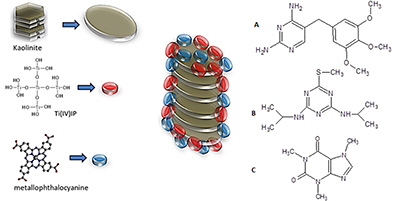
Nanocomposites kaolinite/TiO2/phthalocyanine and molecular structures of organic pollutants used in photodegradation studies.
https://dx.doi.org/10.21577/0103-5053.20190178
J. Braz. Chem. Soc. 2019, 30(12), 2624-2633
Interplay between Near-Field Properties and Au Nanorod Cluster Structure: Extending Hot Spots for Surface-Enhanced Raman Scattering
Klester S. Souza; Erico Teixeira-Neto; Marcia L. A. Temperini; Diego P. dos Santos
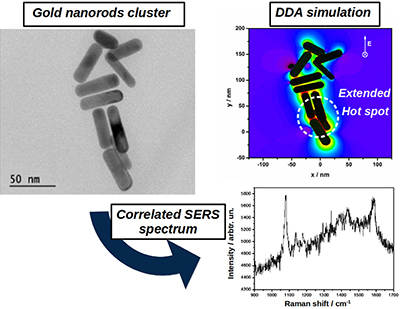
Correlation between surface-enhanced Raman scattering (SERS) spectrum and gold nanorod cluster structure; end-to-end with side-by-side interactions may lead to strong enhancements.
https://dx.doi.org/10.21577/0103-5053.20190179
J. Braz. Chem. Soc. 2019, 30(12), 2634-2641
Cardol-Derived Organophosphorothioates as Inhibitors of Acetylcholinesterase for Dengue Vector Control
Mayara O. Almeida; Thayllan T. Bezerra; Nayane M. A. Lima; Anderson F. Sousa; Maria T. S. Trevisan; Viviane G. P. Ribeiro; Diego Lomonaco  ; Selma E. Mazzetto
; Selma E. Mazzetto

Larvicidal action of organophosphorothioates derived from cardol through inhibition of the acetylcholinesterase enzyme.
https://dx.doi.org/10.21577/0103-5053.20190181
J. Braz. Chem. Soc. 2019, 30(12), 2642-2648
Photochemical Synthesis of Ag and Au Nanoparticles Using a Thioxanthone Substituted Chitosan as Simultaneous Photoinitiator and Stabilizer
Silvano R. Valandro; Alessandra L. Poli; Miguel G. Neumann; Carla C. Schmitt
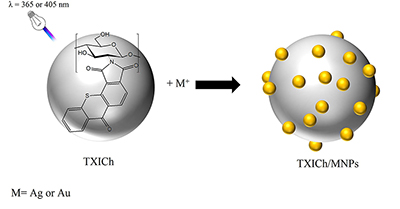
Silver and gold nanoparticles were formed by irradiating the metal salt in the presence of a thioxanthone-derivated chitosan that acts as photoinitiator and stabilizer.
https://dx.doi.org/10.21577/0103-5053.20190182
J. Braz. Chem. Soc. 2019, 30(12), 2649-2659
Light Response of Three Water-Soluble MnI PhotoCORMs: Spectroscopic Features and CO Release Investigation
Vitor C. Weiss; André L. Amorim; Fernando R. Xavier; Adailton J. Bortoluzzi; Ademir Neves; Rosely A. Peralta
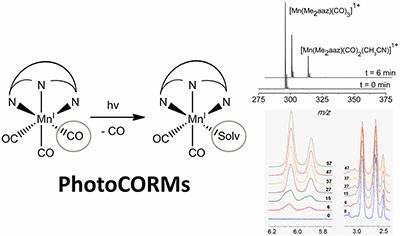
Water-soluble MnI compounds release CO when exposed to light. The proposed mechanism occurs in two steps, with photo and redox processes.
https://dx.doi.org/10.21577/0103-5053.20190183
Total access: 2576
J. Braz. Chem. Soc. 2019, 30(12), 2660-2671
Silica/Titania Graphite Composite Modified with Chitosan and Tyrosinase Employed as a Sensitive Biosensor for Phenolic Compounds
Marina T. Laranjo; Franciele M. Morawski; Silvio L. P. Dias; Edilson V. Benvenutti; Leliz T. Arenas; Tania M. H. Costa
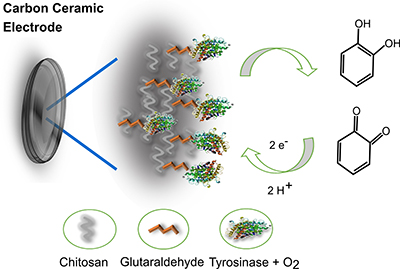
Biosensor based on new carbon ceramic electrode prepared with silica-titania/graphite composite and modified with chitosan for tyrosinase immobilization.
https://dx.doi.org/10.21577/0103-5053.20190190
J. Braz. Chem. Soc. 2019, 30(12), 2672-2680
Structure and Absolute Configuration of Secondary Metabolites from Two Strains of Streptomyces chartreusis Associated with Attine Ants
Humberto E. Ortega  ; Joao M. Batista Jr.
; Joao M. Batista Jr.  ; Weilan G. P. Melo
; Weilan G. P. Melo  ; Gabriela T. de Paula; Mônica T. Pupo
; Gabriela T. de Paula; Mônica T. Pupo

Natural products produced by Streptomyces chartreusis strains associated to Brazilian fungus-growing ants. Absolute configurations of strepchazolin A (3) and strepchazolin B (4) were determined by vibrational circular dichroism (VCD) and ecological function of cyclooctasulfur (5) was established.
https://dx.doi.org/10.21577/0103-5053.20190194
J. Braz. Chem. Soc. 2019, 30(12), 2681-2690
Nanoparticles of Fe2O3 and Co3O4 as Efficient Electrocatalysts for Oxygen Reduction Reaction in Acid Medium
Ismael C. B. Alves; José R. N. Santos; Deracilde S. S. Viégas; Edmar P. Marques; Cristina A. Lacerda; Lei Zhang; Jiujun Zhang; Aldaléa L. B. Marques
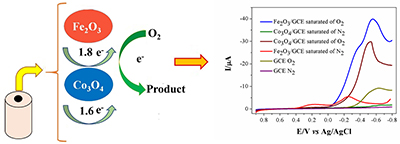
Oxygen reduction reaction (ORR) catalyzed by nanoparticles of Fe2O3 and Co3O4 applied on the surface of a glassy carbon electrode (GCE).
https://dx.doi.org/10.21577/0103-5053.20190195
J. Braz. Chem. Soc. 2019, 30(12), 2691-2701
Analysis of the Seasonal Variation in Chemical Profile of Piper glabratum Kunth Essential Oils using GCxGC/qMS and Their Antioxidant and Antifungal Activities
Anaí L. dos Santos; Allan S. Polidoro; Cláudia A. L. Cardoso; Jonas S. Mota; Rosângela A. Jacques; Elina B. Caramao

The influence of seasonality on chemical composition, antioxidant and antifungal activities of Piper glabratum essential oils was evaluated. The two-dimensional gas chromatography coupled with quadrupole mass spectrometry (GCxGC/qMS) allowed the detailed chemical characterization and the oils showed biological activities. Composition and activities were influenced by seasonality.
https://dx.doi.org/10.21577/0103-5053.20190196
J. Braz. Chem. Soc. 2019, 30(12), 2702-2711
Transmissive to Dark Electrochromic and Fluorescent Device Based on Poly(fluorene-bisthiophene) Derivative
Fred A. R. Nogueira; Ana Julia C. da Silva; Johnnatan D. de Freitas; Amanda S. Tintino; Anna Paula L. A. Santos; Italo N. Oliveira; Adriana S. Ribeiro
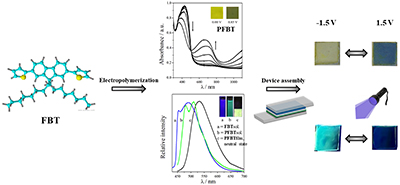
Electrochromic and fluorescent device based on poly(fluorene-bisthiophene) derivative.
https://dx.doi.org/10.21577/0103-5053.20190202
J. Braz. Chem. Soc. 2019, 30(12), 2712-2720
High Throughput Mass Spectrometry Platform for Prospecting High Value Chemicals from Bioconversion of Glycerin
Diana R. Amazonas  ; Augusto L. Souto; Flávia S. Vieira; Andréia A. J. Carneiro; Rebeca B. Vianna; Thaís D. Mendes; Karen S. Lima; José A. A. Ribeiro; Mônica C. T. Damaso; Clenilson M. Rodrigues; Patrícia V. Abdelnur
; Augusto L. Souto; Flávia S. Vieira; Andréia A. J. Carneiro; Rebeca B. Vianna; Thaís D. Mendes; Karen S. Lima; José A. A. Ribeiro; Mônica C. T. Damaso; Clenilson M. Rodrigues; Patrícia V. Abdelnur

High throughput mass spectrometry platform for prospecting high value chemicals from bioconversion of glycerin by filamentous fungi.
https://dx.doi.org/10.21577/0103-5053.20190210
J. Braz. Chem. Soc. 2019, 30(12), 2721-2730
Bioaccessibility of Zinc from Yogurt and Determination of Total Concentration Using Slurry Sampling and Flame Atomic Absorption Spectrometry
Camila K. de Andrade  ; Jucimara K. de Andrade; Vanessa E. dos Anjos
; Jucimara K. de Andrade; Vanessa E. dos Anjos  ; Sueli P. Quináia
; Sueli P. Quináia

The bioaccessibility of Zn was determined from yogurt by flame atomic absorption spectrometry (FAAS). Slurry sampling procedure, in total Zn determination in yogurt by FAAS, was used.
https://dx.doi.org/10.21577/0103-5053.20190213
Online version ISSN 1678-4790 Printed version ISSN 0103-5053
Journal of the Brazilian Chemical Society
JBCS Editorial and Publishing Office
University of Campinas - UNICAMP
13083-970 Campinas-SP, Brazil
Free access










